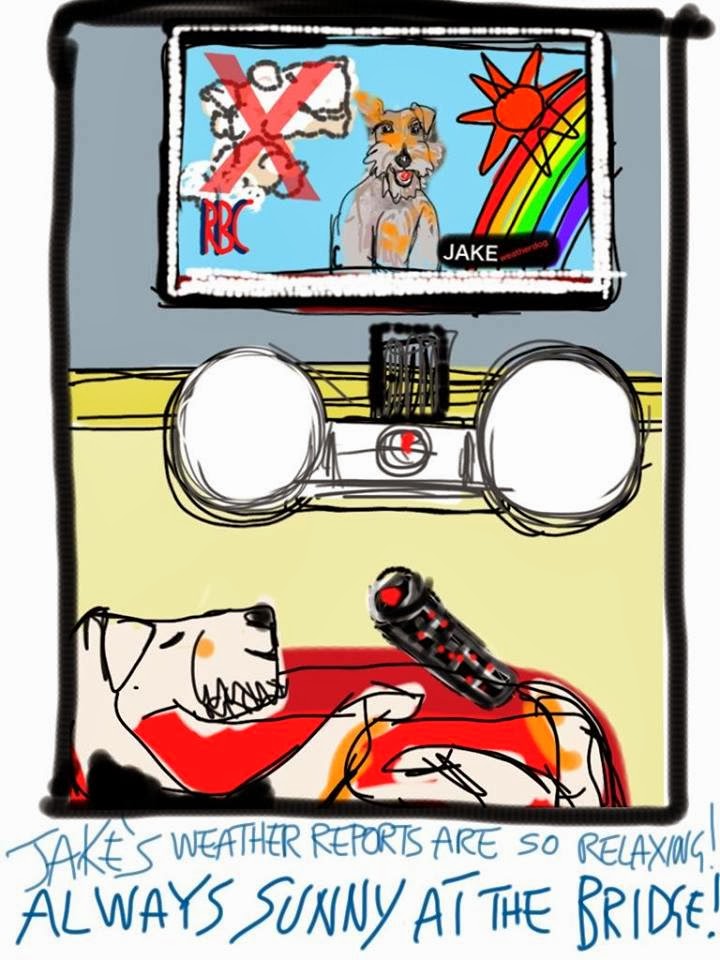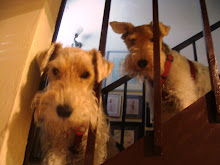
Whenever our mom goes on one of her "business trips," we both know she'll be bringing lots of stuff home with her. Sometimes it's treats for us. Sometimes new collars. Sometimes a stuffie or two. But most often it's something that goes on a wall (except we're pretty much out of wall space). Or something that goes on a shelf or a table (except we're pretty much out of empty flat surfaces too.). Or it's something that goes into a book case (30 pounds came back from Vancouver... and there's not much space to spare in the book cases either).
So we were kind of holding our breath when she came back from Nova Scotia. A few books, check. A calendar, check. A few prints, check. But nothing prepared us for this:


What is it you're probably wondering ?
According to mom, it's a musk ox sculpted by an Inuit artist. Just what we needed, eh?

Muskoxen *
Should you be lucky enough to see the trademark shaggy coat of the muskox (umingmak), you may feel like you've been transported back in time. Indeed, it's easy to imagine continental ice sheets covering much of North America — as they did some 18,000 years ago — when in the company of the "bearded one."
Unlike the caribou, which prefer slow-growing lichens, muskoxen depend largely on grasses and sedges that recover relatively quickly from heavy grazing. In the summer, these herbivores may be seen in river valleys, along lake shores and near damp meadows. If grasses and sedges become unavailable in winter, muskoxen move onto ridges and hilltops to feed on willows and other plants. They are often seen in groups of 10 to 20, depending on season and location. When threatened, muskoxen form defensive circles with adults facing outwards and calves in the centre. This behavior, while effective against four-legged predators, makes muskoxen easy prey for human hunters.
Large numbers of muskoxen roamed the tundra of Nunavut before the arrival of European and Canadian traders. The subsequent market for meat and hides reduced their populations to dangerously low numbers until Canada protected them in 1917. Since then, muskoxen have recovered and recolonized most of their historic range so that closely regulated harvesting can be sustained. Today, Nunavut holds most of Canada's muskoxen, with about 60,000 animals. The species occupies much of Nunavut, except for the eastern mainland and Baffin Island.
Inuit do not usually prefer muskoxen over caribou, although the meat can be delicious and the skins produce warm sleeping robes. Beginning in May, muskoxen shed large quantities of their underfur (qiviut), which can be spun into a luxurious wool. Bulls weigh about 350 kilograms, some 50 kilograms heavier than cows. Muskoxen mate in the summer; bulls can become unpredictable during this period. Do not approach muskoxen too closely, especially if you're not accompanied by an experienced guide. They can be aggressive.
ABOUT THE WOOL²: The Oomingark [as the Inuit call it] is covered all over with "wool", except for it's horns,hooves, lips and nose, with an underlayer of short fine wool for exceptional warmth. Amuch longer outer coat composed of shaggy hair up to 24" in length covers theanimal, hanging nearly to the ground and giving the muskox its mystic appearance.
The coat is generally dark brown or nearly black. About the shoulders it is extremelyshaggy and forms a distinct mane, especially noticeable on bulls. Behind the shoulder is a short white or creamy yellow "saddle". The lower legs have light brown to white "stockings".
* - Reproduced from an article Land Mammals by Marian and Mike Fergusoncontained in the Nunavut Handbook
2 - Reproduced from NWT Wildlife Sketches Series - Muskox of tje Northwest Territories This new guy, who apparently is to make himself at home somewhere up high where we can't reach him, is kind of heavy -- his dense little body weighs about two pounds. And -- this is for Gail and Bertie -- we think he's made of serpentine, one of the rock formations prevalent in parts of Canada. He does have a few Inuit cohorts here from previous forays -- but so far hasn't joined them.We do seem to have one thing in common: musk oxen have double coats, just like we do. But is that enough to be BFFs?
So far, he hasn't a name -- although Mak, short for umingmak, the Inuit word for musk ox, is a starter. And he seems rather staid (no, Lacie, we're not sure if he dates or not). But we can't help but wonder: who needs this?
 When you have one of these???
When you have one of these???  And one of these???
And one of these???

Just askin'.
Jake and Just Harry






 Art is everywhere. Dogdad spotted this trompe l'oeil on a building while they were waiting for a shuttle to take them to the convention site one evening.
Art is everywhere. Dogdad spotted this trompe l'oeil on a building while they were waiting for a shuttle to take them to the convention site one evening.













